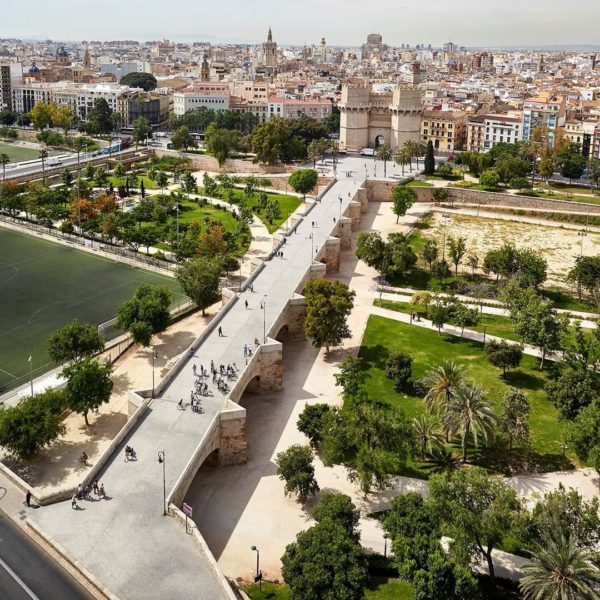Valencia, European Green Capital 2024: A Model City in Sustainability
In 2024, Valencia earned the title of European Green Capital a distinction still relatively unknown to the general public but highly symbolic for experts in ecological transition. This award, granted each year by the European Commission, honors cities that implement ambitious policies to improve their environment, mobility, resource management, and, more broadly, the quality of life of their residents.
Against all odds, Spain’s third-largest city was crowned this year, ahead of more widely publicized metropolises. A strong signal: urban sustainability is not limited to capital cities. Valencia proves that a city can profoundly rethink its operations and become an open-air laboratory for today’s and tomorrow’s climate challenges.
Green spaces at the heart of neighborhoods, an expanding network of bike lanes, local food production, renewable energy, technological innovation… the city is multiplying concrete and measurable initiatives while actively involving its residents.

Elected European Green Capital 2024, Valencia is betting on nature, soft mobility, and a more sustainable city for everyday life.
Green spaces at the heart of the urban projects
Valencia’s transformation is first and foremost reflected in its green spaces. With the Turia Garden, created on the former riverbed, the city has consistently worked to re-naturalize its territory. Today, nearly 90% of the population lives less than 250 meters from a green space. This encourages walking and leisure: in this context, nearly 1,700 trees were planted in 2022, and the ongoing development of the Turia will eventually connect all the way to the Mediterranean. (Pretto)
Around the city, two major parks reinforce this objective: the Turia Natural Park, spanning 8,000 hectares of Mediterranean forest, and above all the Albufera, classified as a wetland of international importance, which could soon be designated a UNESCO Biosphere Reserve.
Rethinking car-free mobility and public space sharing
But that’s not all! Valencia has also launched a green mobility strategy. The city now boasts over 160 km of bike lanes and a strengthened public transport network, including metro and bus services. Pedestrian zones are multiplying: the transformation of major central squares has already returned 150,000 m² to residents, and 22 new superblocks are set to further reshape neighborhoods.
This reconfiguration of public spaces goes hand in hand with strong measures against noise pollution: 67% of streets are now limited to 30 km/h, which has already led to a reduction in decibel levels.
Energy efficiency and innovation
In terms of energy efficiency, since 2015 the city has halved its consumption by introducing energy-saving public lighting (cutting 16,000 tons of CO₂) and massively deploying solar panels on municipal buildings, generating the equivalent energy supply for 27,400 households.
More original and innovative, the Wave Energy Converter project harnesses wave power to produce 130,000 kWh of electricity per year.
Valencia has also been selected as a European super-hub for the Citcom.ai project, which tests artificial intelligence for sustainable mobility, waste management, and energy efficiency, according to Valenciaes.com .
Water and waste management
Water is another key lever. The city is gradually installing public filtered water fountains (22 already in service), saving 600 tons of CO₂ compared to bottled water consumption. Similarly, smart brown bins for organic waste are being introduced, alongside composters for schools and urban gardens, according to lepetitjournal.com .
A more local and sustainable food system
Valencia also promotes more responsible consumption through its agro-ecological markets—spaces dedicated to products grown with farming practices that respect the environment, biodiversity, and people, going beyond simple organic certification. Spread across neighborhoods such as Benimaclet, Malilla, and Castellar-l’Oliveral, these markets allow residents to buy fresh seasonal fruits and vegetables directly from producers. This reduces transport emissions, supports the local economy, and enhances the value of agricultural land around the city.
Beyond food, these markets foster social ties: residents and visitors engage with farmers and rediscover forgotten varieties. They thus play a key role in enabling a more sustainable, local, and environmentally friendly food transition.
A vision for 2030
All these new projects clearly aim for carbon neutrality by 2030. The city is betting on cooperation between institutions, residents, and businesses to turn its ambitions into reality. As the European Commission points out, Valencia has not only learned from the past—particularly the devastating Turia floods of 1957—but has used these experiences to drive innovation through new infrastructures.
With its 789,000 inhabitants, five million square meters of green spaces, and its future projects, Valencia has become an international benchmark for urban sustainability.
